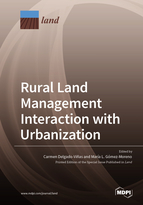Rural Land Management Interaction with Urbanization
A special issue of Land (ISSN 2073-445X). This special issue belongs to the section "Urban Contexts and Urban-Rural Interactions".
Deadline for manuscript submissions: closed (25 October 2022) | Viewed by 29513
Special Issue Editors
Interests: mountain areas; rural areas dynamics; rural depopulation; rural development; urbanization processes
Special Issues, Collections and Topics in MDPI journals
Interests: Mediterranean mountain areas; local development; regional policies impact on territories
Special Issues, Collections and Topics in MDPI journals
Special Issue Information
Dear Colleagues,
This Special Issue focuses on how recent urbanization processes modifies the organization and management of the land uses at integrated rural areas in peri-urban and intra-metropolitan areas at local, national, and global levels.
Recent rural dynamics are primarily characterized by three interrelated trends: economic diversification, deagrarianization, and depopulation; the first two of which common to all rural areas.
It is true that deagrarianization and the simultaneous shift towards a service economy in present-day rural economies and societies have not led to the disappearance of rural space but instead some rural areas are presenting extraordinary territorial and economic transformation. These comprise zones that fall between the countryside and the city where intensive rural urbanization or peri-urbanization processes are taking place.
In the past, primary sector activities were very important, but their importance has steadily declined in both absolute and relative. Agricultural activity has become relatively unimportant as urban activities and functions acquire greater prominence.
This has substantially weakened and modified agricultural activities and transformed land use patterns in rural regions.
Nevertheless, in recent decades, agricultural activities had received new functions in peri-urban areas. As a common factor of all them, the acknowledgment of biodiversity and heritage values in the agricultural uses and the compatibility of both with quality food production. These concepts include eco-system services, peri-urban agricultural parks or home market agriculture, and urban productive landscapes.
Land use policy, especially legal regulations relating to construction land supply, are critical tools to harness territorial development. The policy trajectory of construction land supply entails a complicated reconfiguration of public functions, which is driven by rural–urban relations. The integrated urban-rural development should be raised through the experimentation of a new use policy and land management.
Many unanswered questions remain regarding the impacts of urbanization on rural areas. Contributions to this Special Issue could serve to provide some answers.
We invite papers that link countryside urbanization, deagrarianization, land management, land use planning, urban sprawl into rural areas, and integrated rural-urban development.
Prof. Dr. Carmen Delgado-Viñas
Prof. Dr. María L. Gómez-Moreno
Guest Editors
Manuscript Submission Information
Manuscripts should be submitted online at www.mdpi.com by registering and logging in to this website. Once you are registered, click here to go to the submission form. Manuscripts can be submitted until the deadline. All submissions that pass pre-check are peer-reviewed. Accepted papers will be published continuously in the journal (as soon as accepted) and will be listed together on the special issue website. Research articles, review articles as well as short communications are invited. For planned papers, a title and short abstract (about 100 words) can be sent to the Editorial Office for announcement on this website.
Submitted manuscripts should not have been published previously, nor be under consideration for publication elsewhere (except conference proceedings papers). All manuscripts are thoroughly refereed through a single-blind peer-review process. A guide for authors and other relevant information for submission of manuscripts is available on the Instructions for Authors page. Land is an international peer-reviewed open access monthly journal published by MDPI.
Please visit the Instructions for Authors page before submitting a manuscript. The Article Processing Charge (APC) for publication in this open access journal is 2600 CHF (Swiss Francs). Submitted papers should be well formatted and use good English. Authors may use MDPI's English editing service prior to publication or during author revisions.
Keywords
- countryside urbanization
- deagrarianization
- land management
- land use planning
- urban sprawl on rural areas
- integrated rural-urban development







